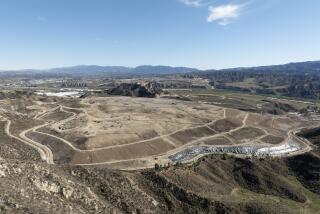La Conchita Landslide Case
- Share via
* Re “La Conchita Landslide,” letter, Jan. 24.
This letter is most notable for its lack of accuracy in describing both the farming practices at La Conchita Ranch and the conditions in the courtroom. It overstates the size of the plantings at the ranch by nearly 200 acres and is way off the mark in claiming the trees used “billions of acre-feet of water.” If I were to double our average annual application of irrigation water, I would break into the billions category a little over 1.5 million years from today.
As to the courtroom conditions, they were agreed to by both sides, in an effort to bring a timely end to a long-standing dispute between neighbors. The agreement by both parties to hear the case without a jury and to bifurcate the case to focus only on the issue of causation for the landslide allowed the case to be heard at an earlier date and be focused on the only important issue: Did irrigation cause the landslide?
After six weeks of testimony, that question has been answered: No, irrigation did not cause the landslide.
The evidence presented by both sides represented nearly three years of investigation and monitoring. Each side was allowed ample time to completely present its evidence.
The issue of causation obviously focused on agricultural management practices involving both irrigation and rainfall moisture within the root zone area of the orchards. The plaintiffs elected to present their case without the use of either an agricultural expert or an irrigation engineer and chose to collect root zone moisture samples only during the rainfall season, never during the irrigation season. The defendants presented a case that included near-daily monitoring of root zone moisture conditions throughout the year, as well as the monitoring of any moisture moving past the root zone. The only moisture moving down and out of the root zone area (and thus able to influence ground water recharge) occurred as a result of high levels of rainfall. The January immediately preceding the landslide was the wettest month during the history of area rainfall records.
The residents of the village of La Conchita and the owners of La Conchita Ranch have both suffered as a result of the landslide. It is best for all parties [to accept] that all views have been fully and fairly heard and the questions regarding the relationship between irrigation and the landslide have been answered.
DAVID A. ORR
Manager
La Conchita Ranch
Ventura
*
* Re “La Conchita Residents to Pursue Slide Dispute,” Jan. 19.
I feel compelled to comment regarding statements attributed to David Orr, La Conchita Ranch manager, saying, “Our farm is in total compliance with the coastal permits.” Perhaps Mr. Orr is unfamiliar with the requirements of their original coastal permit, dated Nov. 7, 1974, which gave La Conchita Ranch permission to develop an irrigated avocado orchard above the town of La Conchita. Because of concerns about severe erosion and possible adverse impact to the town, permission to proceed was given grudgingly by the California Coastal Commission and only with the stipulation that the ranch prepare a comprehensive erosion-control and drainage plan in collaboration with the federal Soil Conservation Service and the Natural Resource Conservation Service. The plan was to be completed within 90 days and fully implemented within one year after that. The plan and its implementation were never done. The La Conchita Ranch has not followed the most critical stipulation of its permit, and the results have been disastrous. The plan needs to be created and implemented as soon as possible. The ranch agreed to the conditions of the permit in 1974. It would create good will with the community by actually following through with it.
Regarding Mr. Orr’s statement “ . . . and in reviewing the conditions of the erosion plan, it looks like we’re also in compliance with that,” I believe he is speaking about the Ventura hillside erosion-control ordinance, passed in 1981 by the Board of Supervisors to control the tremendous problems stemming from avocado and citrus development on steep hillsides during the 1970s. That ordinance requires ranches that develop or replant orchards on highly erodible sites to prepare an erosion-control plan subject to approval by the Natural Resource Conservation Service and the county public works department. La Conchita Ranch has not submitted any such plan and thus is not in compliance.
The county of Ventura and the California Coastal Commission do have a legal and moral responsibility to ensure that the La Conchita Ranch complies with its original coastal permit and the hillside erosion-control ordinance, but the ranch would be wise to take a leadership role in developing and implementing such a plan in cooperation with the community and the proper agencies. Everyone would benefit and the ranch would be making a much needed goodwill gesture while covering itself legally, both in terms of compliance and reducing future liability.
DOUG RICHARDSON
La Conchita
More to Read
Sign up for Essential California
The most important California stories and recommendations in your inbox every morning.
You may occasionally receive promotional content from the Los Angeles Times.













